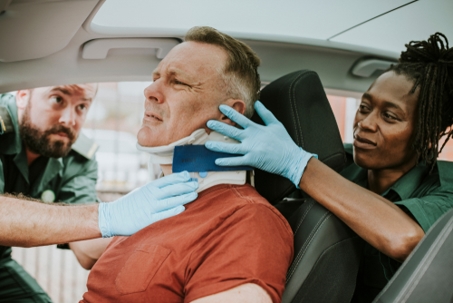In 2019 alone, nearly 167,000 Texans were in an accident with possible injuries. If you are one of the hundreds of thousands of drivers dealing with the outcome of a car crash, you are familiar with the stress of speaking with an insurance company. So, what do you do if you’ve been in a car wreck and how does accident insurance work?
What Do I Do When I’ve Been in an Accident?
Car accidents can be traumatic, and it’s hard to think proactively about what you should do. Always check to see if you or the others in the accident have injuries and call emergency services as soon as possible. The Texas Transportation Code also states that the driver of any car involved in an accident should report it to the police as quickly as possible, especially if the crash resulted in the injury or death of another person, or if the damage prevents the vehicle from being driven safely from the scene.
Also, take note of your surroundings. If you can, take pictures of the damage to your vehicle and any other relevant evidence related to the accident, especially if your accident was caused, in part, by environmental conditions like rain or snow. Fault is an integral part of the claims process in Texas, so it is important to have as much evidence as possible to support your case and prove that you were not at fault.
There are no official laws that say when to call your insurance company, but generally, it is best to speak with your insurer as soon as possible. The sooner your insurance company knows about the accident, the sooner they can investigate your claim. Keep in mind that there is a two-year statute of limitations for Texas car accident claims, and policyholders who do not report within that time period may not be able to file a lawsuit.
Texas Comparative Negligence Rule
In most auto accident cases, it isn’t always clear who is at fault, and both parties may share some of the blame. Texas has a modified comparative fault rule that applies to situations where there is negligence, but both parties share a percentage of the responsibility.
Usually, in a court case, the jury must calculate the total amount of damages and the percentage of fault of each party. Using the comparative negligence rule, the court reduces the amount of damages awarded to you by your percentage of fault.
For example, if the jury decides that the total damages award should be $10,000, but you are 40% at fault for the accident, the final amount you would receive would be $6,000. A key point of the comparative negligence rule to remember is that if you are more than 50% at fault for the accident, you will not receive damages.
This rule helps to ensure that the court makes a reasonable decision regarding the damages award, and it also provides guidance to your insurer when evaluating your case.
Auto Insurance Requirements for Drivers
Because Texas requires drivers to pay for their share of damages after an accident, many drivers choose to carry insurance to help cover the cost of a car wreck. The law requires drivers to have minimum amounts of liability insurance, also known as 30/60/25 coverage.
The insurance minimums are as follows:
- $30,000 for injury liability per person in an accident where you are at fault
- $60,000 for total injury liability where two or more people are injured if you are at fault
- $25,000 for property damage per accident where you are at fault
These insurance minimums cover medical bills, property damage, and other costs associated with drivers, passengers, or pedestrians injured in an accident. You can add more coverage to protect you in the event of a more serious accident, but remember that you are responsible for paying any remaining costs out of pocket once you have met your policy limits.
Always carry your insurance information with you. Law enforcement officers may ask to see proof of insurance if you are in an accident or during a traffic stop. Failure to provide it may result in fines or penalties depending on the situation.
It’s also important to understand that 30/60/25 liability insurance does not cover you but rather the damage or injuries of the other party. Consider adding more coverage to protect you and cover damages to your property or vehicle in case of an accident. Collision coverage and personal injury protection plans can help cover the cost of your medical bills and repairs.
If you have questions about your accident, insurance coverage, or you need legal counsel after an accident, don’t hesitate to contact the Zambrano Law Firm today.

